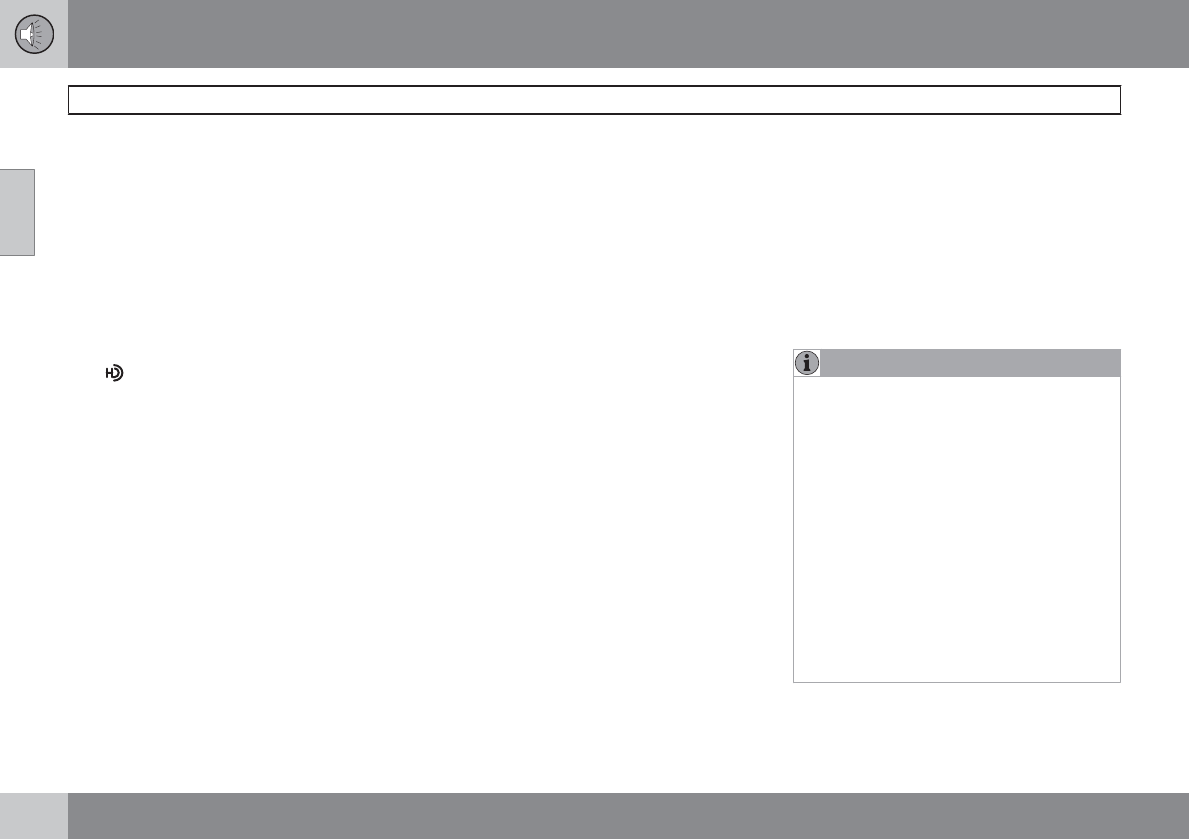
10 Audio
Radio functions
10
254
quency as the AM or FM station's present fre-
quency.
The IBOC system is referred to as a "hybrid"
since it is both analogue and digital. During
hybrid operation, receivers still continue to
receive the analogue (non-digital) signal. HD
radio receivers incorporate both modes of
reception, where the receiver will automatically
switch to the analogue signal if the digital signal
cannot be decoded or is lost by the receiver.
When you have tuned to an HD Radio station,
the
symbol will appear in the audio sys-
tem display.
More information about HD radio and IBOC
can be found on Ibiquity's website,
www.hdradio.com and www.ibiquity.com.
Benefits of digital broadcasting
•
Better sound (FM sounds near CD quality
and AM as analogue FM).
•
Some FM frequencies offer a greater num-
ber of listening choices through “multicast-
ing” (consisting of a frequency's main
channel and any sub-channels that may
also be available on that particular fre-
quency. See also the section "Sub-chan-
nels" below).
•
When receiving a digital signal there is no
multipath disturbance or hisses/pops/
crackling due to outside influences.
How HD broadcasting works
HD Radio works similarly to conventional radio
and broadcasts of this type are available in
many areas of the United States. However,
there are a few key differences:
•
Instead of transmitting one analogue sig-
nal, stations send out a bundled signal –
both analogue and digital.
•
An HD radio receiver can receive both dig-
ital and analogue broadcasts. Depending
on the terrain and location of the vehicle
(which will influence the signal strength),
the receiver will determine which signal to
receive.
Limitations
•
Main channel vs. sub-channels (FM
only): The main channel is the only channel
that can receive in hybrid mode (both dig-
ital and analogue). If a frequency has sub-
channels, they are broadcast in digital
mode only. The main FM channel will be
displayed as, for example, 93.9 WNYC
(Volvo uses the symbol > to indicate there
are sub-channels available) The sub-FM
channels will be displayed as 93.9 – 2
WNYC, 93.9 - 3 WNYC, etc.
•
Reception coverage area: Due to current
IBOC transmitter power limitations, the
reception coverage area in digital mode is
somewhat more limited than the station's
analogue coverage area. Please be aware
that as with any radio broadcast technol-
ogy, terrain, time of day, foliage level and
building location can have positive or neg-
ative effects on radio reception.
•
Analogue to digital/digital to analogue
blending: Analogue to digital blending will
occur as the signal strength reaches a pre-
set threshold in the receiver. This will be
noticeable in fringe areas (areas with weak
reception) and is normal.
NOTE
There may be a noticeable difference in
sound quality when a change from analogue
to digital or digital to analogue occurs, such
as:
•
Volume increase or decrease
•
Equalizer settings, i.e., Bass/ Midrange/
Treble cut or boost
•
Time alignment (Digital program mate-
rial in extreme cases can be as much as
8 seconds behind the analogue). This
will noticeable as a "stuttering" effect.
The above items are dependant on the
broadcaster's equipment settings and do
not indicate a fault in the vehicle's radio
receiver or antenna systems.


















